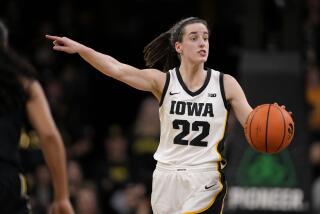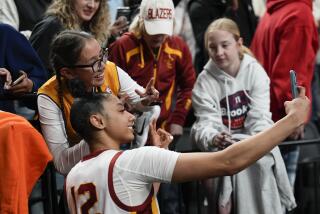WOMEN’S BASKETBALL / EARL GUSTKEY : Ban Would Close a Lucrative Market
When they blow the final horn on the night of April 4 at the women’s basketball Final Four, what then?
After they turn out the lights and the players and coaches leave and line up for the airport vans, another wave of talented U.S. female players will look ahead to the two worlds of women’s pro basketball, two oceans apart.
There is no pro women’s basketball in the United States, not since the Women’s Basketball League folded in the 1980s.
About 125 American women play pro ball overseas. And there is no news on anyone starting another league in the U.S.
Instead, the news is even worse for American women who desire to play pro basketball. It is rumored pro basketball administrators in Japan, where about 25 Americans are playing, will ban Americans from playing there for at least one year, beginning next season.
Rumors of a ban on Americans prompted New York player-agent Bruce Levy to visit Japan recently. He has placed about 50 women in Japan’s league in recent years. American players in Japan earn from $75,000 to $200,000, receive free apartments and cars, and are excused from Japan income taxes.
Not NBA money, but not bad.
Levy says the ban came about because some of Japan’s Olympic development officials feared tall American women were dominating shorter Japanese centers, hindering preparation for the Olympics.
“I met with the Japanese people and I asked them if they’d considered the public relations nightmare they could have--if they permanently banned U.S. players, most of them minority American women.
“Now I have a clearer picture of what’s happening. There will almost certainly be a ban next year, but I think it will be just for one year. Most of the basketball people I talked to were not in favor of excluding U.S. players, but the old-guard men who run the sponsoring corporations carried the day.
“There is now a great deal of sensitivity in Japan to this question. None of the people I talked to wanted to be perceived as denying career opportunities to anyone.
“But they also feel their first responsibility is to Japan’s Olympic program. I suggested limiting U.S. players to those 6-1 or under, but got no response.”
Levy said American women are treated well in Japan.
“It is a major cultural change for them, but they’re treated well,” he said. “And not once have I had a single problem in getting a team to pay a woman what she’s owed. And that includes all 50 players I’ve sent over there.
“I’m preparing now to file suit against seven teams in Italy and Spain who stopped paying our players.”
Levy said Japan has the highest salaries. Next come Italy (average: $75,000); Brazil and France ($50,000), and Spain ($25,000). On the low end, Luxembourg and Australia average about $1,500 per month.
How much would USC’s 6-foot-5 Lisa Leslie command as a pro?
“Lisa would get several hundred thousand a year in Europe, even if Japan isn’t there for leverage,” Levy said.
Of a American women’s pro league, Levy said:
“It won’t happen unless someone like Donald Trump or the NBA gets behind it. It’s a huge marketing project, and it requires backers with long-term vision, able to ride out the lean early years.”
One who was left with a sour taste of women’s pro basketball in the U.S. is Ann Meyers, the 1970s UCLA All-American.
“I haven’t heard a thing about a new league,” she said. “You need someone with a lot of money and who is also willing to treat women pros like pro athletes.”
Meyers played one season with Houston in the WBA, then quit when her team stopped paying her.
“The whole experience was awful,” she said. “Those people still owe me $85,000.”
Levy, however, holds out hope for a league in the U.S.
“I’ll tell you who would be happiest of all,” Levy said. “My 1992 phone bill was $42,000.”
Women’s Basketball Notes
The Pac-10 race has come down to a two-team duel between USC and Stanford. They don’t play each other again, and the Trojans, in the season’s final seven games, play only Washington (March 4) and Washington State (March 6) on the road. USC’s remaining home games: UCLA (Feb. 26, 9 p.m., Sports Arena), Arizona State (March 11, Sports Arena) and Arizona (March 13, Lyon Center). UCLA, all but out of it, has home dates remaining against Arizona (March 11) and Arizona State (March 13).
NCAA playoffs start the week of March 17, for teams seeded five through 16 in their regions. Teams seeded one through four get byes. Qualifying for regional play is scheduled for March 19-20-21. The four regionals tournaments will be held March 25 and 27, at Richmond, Va., the University of Iowa, Stephen F. Austin State University at Nacogdoches, Tex., and the University of Montana. The Final Four will be April 3-4 in Atlanta.
More to Read
Go beyond the scoreboard
Get the latest on L.A.'s teams in the daily Sports Report newsletter.
You may occasionally receive promotional content from the Los Angeles Times.










